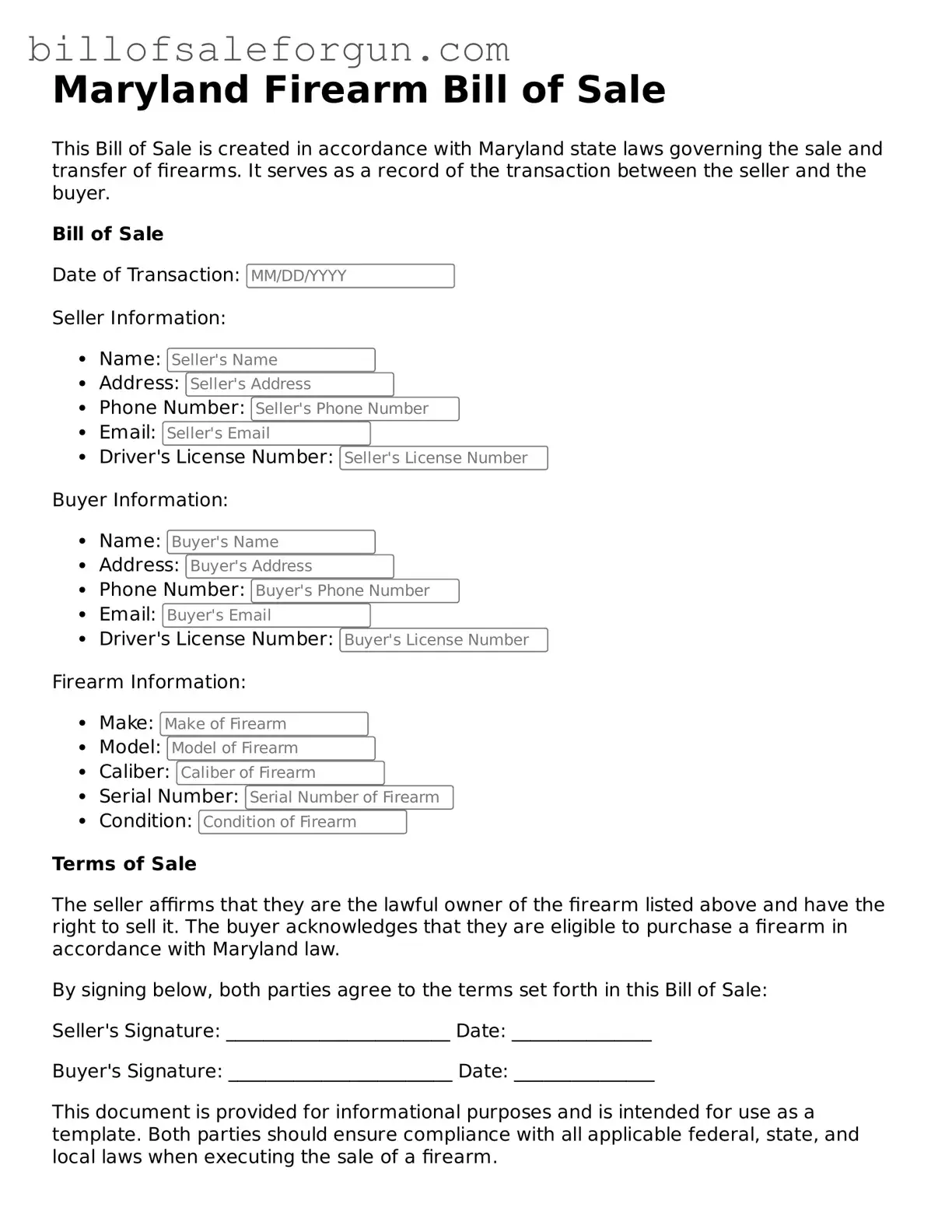Similar forms
The Maryland Firearm Bill of Sale form shares similarities with a Vehicle Bill of Sale. Both documents serve as proof of a transaction, detailing the transfer of ownership from one party to another. In the case of a vehicle, the document includes information such as the vehicle identification number (VIN), make, model, and year. Just like the firearm bill, it requires the signatures of both the buyer and seller, ensuring that both parties acknowledge the transaction and agree to the terms laid out in the document.
Another document akin to the Firearm Bill of Sale is the Boat Bill of Sale. This form is used when transferring ownership of a watercraft. It typically includes details about the boat, such as its hull identification number (HIN), make, model, and year of manufacture. Similar to the firearm transaction, the signatures of both parties are required, and the document acts as a legal record of the sale, protecting both the buyer and seller from potential disputes.
The Personal Property Bill of Sale is also comparable. This document can be used for various types of personal property transactions, such as furniture, electronics, or collectibles. Like the Firearm Bill of Sale, it outlines the specifics of the item being sold, including a description, condition, and sale price. The signatures of both parties validate the transaction, providing a clear record that can be referenced if needed.
A Rental Agreement bears resemblance to the Firearm Bill of Sale in that it establishes the terms of a transaction, albeit for leasing rather than buying. This document details the property being rented, the duration of the lease, and the rental amount. Both agreements require the signatures of involved parties, ensuring that everyone understands and agrees to the terms laid out.
When considering various documents used in business transactions, it’s essential to acknowledge forms like the Business Credit Application, which is crucial for establishing credit relationships. This document not only outlines the fundamental information required to assess creditworthiness but also aligns with other significant forms, such as those found on onlinelawdocs.com, ensuring businesses have the necessary resources to navigate their financial agreements effectively.
The Lease-to-Own Agreement is similar as well. This document outlines the terms for purchasing an item over time, often used for expensive items like appliances or furniture. It specifies the total price, payment schedule, and conditions under which ownership is transferred. Like the Firearm Bill of Sale, it protects both parties by documenting the transaction and their responsibilities.
A Sales Agreement is another document that shares characteristics with the Firearm Bill of Sale. This comprehensive document outlines the terms of a sale, including the item description, purchase price, and payment terms. It serves as a binding contract between buyer and seller, ensuring both parties are clear about their obligations and the details of the transaction.
The Warranty Deed is somewhat similar, especially in the context of real estate transactions. It transfers ownership of property from one party to another. While it’s specific to real estate, it also requires the signatures of both parties and serves as a legal record of the transaction. Both documents provide assurance to the buyer regarding the seller's right to sell the item or property.
The Quitclaim Deed is another document that resembles the Firearm Bill of Sale in its purpose of transferring ownership. This deed is often used in situations where the seller may not have full ownership rights. Like the firearm sale, it requires signatures from both parties and serves as a legal acknowledgment of the transfer, although it offers less protection to the buyer than a warranty deed.
The Affidavit of Sale is also similar, as it serves as a sworn statement confirming that a sale has occurred. This document may accompany a Bill of Sale, adding an extra layer of verification. Both documents require signatures and can be used in legal proceedings to prove that a transaction took place.
Lastly, the Gift Receipt can be compared to the Firearm Bill of Sale in that it documents the transfer of an item, though it is typically used when no money changes hands. It provides a record of the item given as a gift, including details about the item and the parties involved. While it may not involve a purchase price, it still serves as a legal acknowledgment of the transfer, similar to the firearm bill.
